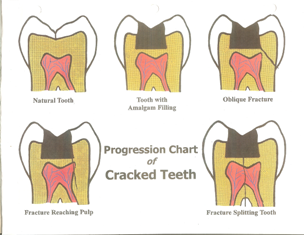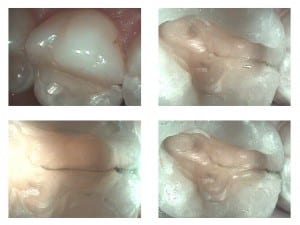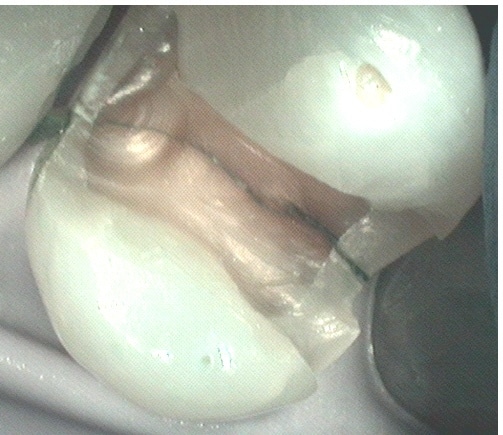You are having frequent but sometimes intermittent pain, discomfort, and sensitivity in your tooth. The cause of the pain is not visible to the naked eye and does not show up on the dental x-rays. You are beginning to wonder if the pain is all in your head until the doctor tells you that you have cracked tooth syndrome.

Treatment of a fractured tooth usually depends on the location of the fracture as well as the extent of the damage. If only the outer enamel is cracked then we remove the affected portion and restore the tooth with a crown or onlay to stabilize it and protect it from further damage. If the crack extends into the underlying dentin or pulp layers then more extensive treatment may be required, such as a root canal, before a final restoration can be placed to stabilize the tooth. In some rare instances, a crack will extend all the way through the tooth and under the bone. In these extreme cases, there is no way to restore the tooth and we have no other option but to extract it. Fortunately, most cracked teeth can be saved. The key is early detection and appropriate treatment. Since diagnosis is often based on patient symptoms, it is very important to tell your dentist of any pain or discomfort you have been experiencing as soon as you have it.

Dr. Beyer’s Fractured Tooth As It Is Revealed
Dr. Craig Beyer of Beyer Laser Center is a good example of a those rare cases where a fracture extends through the tooth. Dr. Beyer came to Dr. Adler complaining of that he was having pain when he was biting down. Based upon the symptoms Dr. Beyer described, photographs, and x-rays, Dr. Adler determined that Dr. Beyer had a fractured tooth and recommended a crown. The tooth was prepped and fitted with an all porcelain Cerec crown. The fracture became even more apparent once the tooth had been prepped for the crown and had decay indicator placed on the tooth. Decay indicator is a dye that helps make decay more visible, it can also be used to see tooth fractures because the dye will run along the crack. Interoral pictures allow the doctor to get an up-close look at the teeth allowing him to see cracks that might otherwise be missed. If the fracture had been an oblique fracture, extending into the enamel or dentin but not the pulp layers, as was first assumed then the crown would have solved the problem. Unfortunately, Dr. Beyer continued to have symptoms of pain. Dr. Adler then performed a root canal believing that the fracture extended into the pulp of the tooth. During the root canal procedure, Dr. Adler saw that fractured propagated through the tooth and that the root canal would not be sufficient treatment to save the tooth. Since the fracture extended through the tooth splitting it, the tooth could not be saved and had to be extracted and replaced with a titanium implant.

Bill’s Uncovered Fractured Tooth
Bill is a common example of cracked tooth syndrome. Bill had been having sensitivity with a tooth on his upper left side for about one year whenever he would bite down but didn’t think much of it since it only hurt when he bit down and wasn’t a constant pain. After mentioning to the hygienist at his cleaning that he was having this continuous problem, the doctor diagnosed a fracture in the tooth. An old filling was removed from the tooth and a decay indicator was placed on the tooth in order to see the extent of the fracture. The decay indicator along with the intraoral pictures allowed Dr. Adler to see that the fracture, an oblique fracture, extended across and into the tooth but had probably not yet entered the pulp chamber. Dr. Adler placed an all porcelain Cerec crown on the tooth to stabilize and to help prevent the fracture from propagating further through the tooth. The crown also kept the fracture from expanding and contracting which can increase the pain or sensitivity that a patient experiences. Since the crown was placed, Bill has been symptom free.
